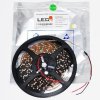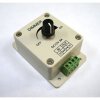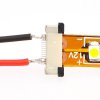I am looking to install LED accent/task lighting in my kitchen and laundry/utility room. I think I have settled on the flexible strips with SMD 12V LEDs that you stick on. These are low profile, sort of directional, and should be hidden from direct view by the cabinet lips and edges and they come in a large roll that can be cut every ~2". They also seem the most economical compared with bar lights or other typical lighting for this application. Has anyone successfully used these for accent task lighting in a kitchen? Are there any other better options in the same price range?
Another of my concerns in general for LV lighting of any type or other LV uses is how to get the 12V to each location. I have 7 separate cabinet groups without any easy or visually appealing way to get power wiring from one group to another. I (really my wife) doesn't want wires going from outlets above the counter going up into the cabinets. I do have some limited access to walls through attic and crawl space so running wiring to a particular location or two is doable. I was hoping there might an elegant solution out there that would allow me to centrally distribute a low voltage from the same location as my other automation equipment. It needs to be able to be automated, have adjustable voltage output to account for drop, have several channels, and be dimmable. I see Altronix and ELK have some stuff. There are also some generic DIY type modules available, but nothing I have seen that really puts it all together. Any suggestions or examples of systems that people have up and running would be awesome. Thanks.
Another of my concerns in general for LV lighting of any type or other LV uses is how to get the 12V to each location. I have 7 separate cabinet groups without any easy or visually appealing way to get power wiring from one group to another. I (really my wife) doesn't want wires going from outlets above the counter going up into the cabinets. I do have some limited access to walls through attic and crawl space so running wiring to a particular location or two is doable. I was hoping there might an elegant solution out there that would allow me to centrally distribute a low voltage from the same location as my other automation equipment. It needs to be able to be automated, have adjustable voltage output to account for drop, have several channels, and be dimmable. I see Altronix and ELK have some stuff. There are also some generic DIY type modules available, but nothing I have seen that really puts it all together. Any suggestions or examples of systems that people have up and running would be awesome. Thanks.










